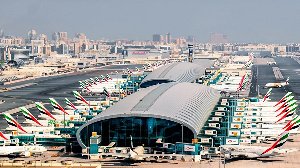Heavy rain has been lashing Gulf states, leading to deadly flash floods and disrupting flights at the world’s second-busiest airport.
Dubai International Airport is grappling with “very challenging conditions,” urging some passengers not to arrive as areas are submerged in water.
In a tragic incident, a man lost his life when his car was swept away in flash floods. Meanwhile, in Oman, rescuers recovered the body of a girl in Saham, bringing the country’s death toll to 19 since Sunday.
Flight operations at Dubai International Airport have been severely impacted, with approximately 290 flights cancelled and 440 delayed as of Wednesday evening, according to Flight Aware data.
Emirates, a key international airline based in Dubai, has halted check-in services for departing passengers until Thursday.
Authorities have cautioned that more thunderstorms, heavy rain, and strong winds are expected, with many low-lying areas still submerged.
The United Arab Emirates, Oman’s northern neighbor, experienced its heaviest rainfall event in 75 years on Tuesday, with 254.8mm (9.7in) recorded in Khatm al-Shakla, al-Ain, in less than 24 hours.
Dubai typically receives only 97mm of rain annually, with the monthly average for April around 8mm. However, Tuesday’s deluge resulted in flooded roads and traffic congestion, including on Sheikh Zayed Road, a major thoroughfare in Dubai.
“I’m trying to get on another flight,” Andrew, 62, told BBC News. “My wife, Kate is standing in another queue as we’re trying to hedge our bets.”
The couple from Kent were on holiday to celebrate Kate’s 60th birthday, a trip Andrew says she will now “never forget”.
“It has been worse I think than anyone expected, but the system within the airport has completely fallen apart and Emirates, which I consider to be one of finest airlines – no staff, no information, no coordination, no professionalism, no care – no disaster planning at Emirates, it’s weird – big companies normally plan for these events.
“It’s been total chaos.
“People are sleeping in the lounges, on the floors, food packets everywhere. It’s just been a pretty filthy experience really.”
At the airport, Anne Wing from Rotherham, South Yorkshire, along with her husband and three children, was hoping to fly to London Heathrow.
They reached the airport at 08:00 local time (04:00 GMT) for their 11:25 flight, only to be informed initially that it had been delayed by an hour.
“We have spoken to no-one from Emirates since 08:00 this morning,” she said.
“Passengers were shouting and rioting at the connection desk, there were no staff to be seen.”
“Its horrific, we are squashed in like animals – it is dangerous and inhumane,” she added. “It’s absolutely ridiculous here”.
She mentioned that her family had not eaten since lunchtime, and the only provisions provided were small cartons of water.
Passengers diverted to another Dubai airport, Dubai World Central, have reported similar experiences, citing a lack of proper meals and water.
No fatalities were reported in Dubai, but an elderly man died when his vehicle was swept away in a flash flood in Ras al-Khaimah.
While the rain had eased by Tuesday evening, Dubai International Airport warned of further disruptions and noted overcrowding.
The intense storm, which began on Tuesday morning and persisted throughout the day, forced the airport to halt operations for 25 minutes, divert several inbound planes, and cancel numerous inbound and outbound flights.
Social media videos depicted aircraft navigating through several inches of water that covered the airport’s apron and taxiways completely.
“We are currently experiencing significant disruption due to the weather and are continuously working with our emergency response teams and service partners to restore normal operations as quickly as possible,” it said on X, formerly Twitter.
Emirates, one of the UAE’s two flag carriers and the world’s largest international airline, told customers that check-in had been suspended at the airport for all flights until Thursday morning.
The chief executive of Dubai Airports, Paul Griffiths, told local radio station Dubai Eye: “In living memory, I don’t think anyone has ever seen conditions like it.”
Software engineer Kanish Kumar Deb Barman, who is stuck at the airport on his way home to India, told Reuters news agency: “There are hundreds and thousands of other passengers just like me in this airport who have been waiting for 10 hours, 16 hours, some even for 24 to 30 hours.”
Before the storm hit, the UAE’s National Emergency Crisis Management Authority issued a warning advising people to stay at home. The government also instructed its employees to work remotely, and private schools were advised to conduct classes online.
In Oman, over 1,400 individuals have been relocated to shelters, and schools and government offices have been shut down as a precautionary measure.
On Sunday, a tragic incident occurred in Oman where 10 schoolchildren aged between 10 and 15, along with an adult, lost their lives when their bus was engulfed by floodwater while attempting to cross a wadi in the al-Mudhaibi area of Sharqiya province, approximately 115km (70 miles) south of the capital, Muscat. Three other children and the driver were rescued, with two of them reportedly airlifted to safety after being swept 600m (1,970ft) from the bus.
The sultanate’s council of ministers expressed deep sorrow over the deaths and extended their condolences to the families of the victims.
Oman typically experiences minimal precipitation, with annual average rainfall ranging from 150 to 300mm in the north, mainly occurring during pre- and post-monsoon storms.
Following the floods, some social media users incorrectly attributed the extreme weather solely to recent cloud seeding operations in the country. Cloud seeding, a process where planes spray clouds with particles to induce rainfall, has been conducted in the United Arab Emirates for over a decade.
However experts say that at best it would have had a minor effect on the storm and that focusing on cloud seeding is “misleading”.
“The UAE does have an operational cloud seeding programme to enhance the rainfall in this arid part of the world, however, there is no technology in existence that can create or even severely modify this kind of rainfall event,” said Prof Maarten Ambaum from the University of Reading.
BBC Weather meteorologist Matt Taylor also noted the storm had already been forecast.
“This was already forecast to be a severe weather event. Ahead of the event, computer models [that don’t factor in potential cloud seeding effects] were already predicting well over a year’s worth of rain to fall in around 24 hours.
“The impacts were much wider than I would expect from cloud-seeding alone too – severe flooding impacting large areas from Bahrain to Oman.”
The heavy rain also hit Saudi Arabia and Bahrain, where videos showed cars stranded in flooded roads.
Many factors contribute to flooding, but a warming atmosphere caused by climate change makes extreme rainfall more likely.
The world has already warmed by about 1.1C since the industrial era began and temperatures will keep rising unless governments around the world make steep cuts to emissions.










































